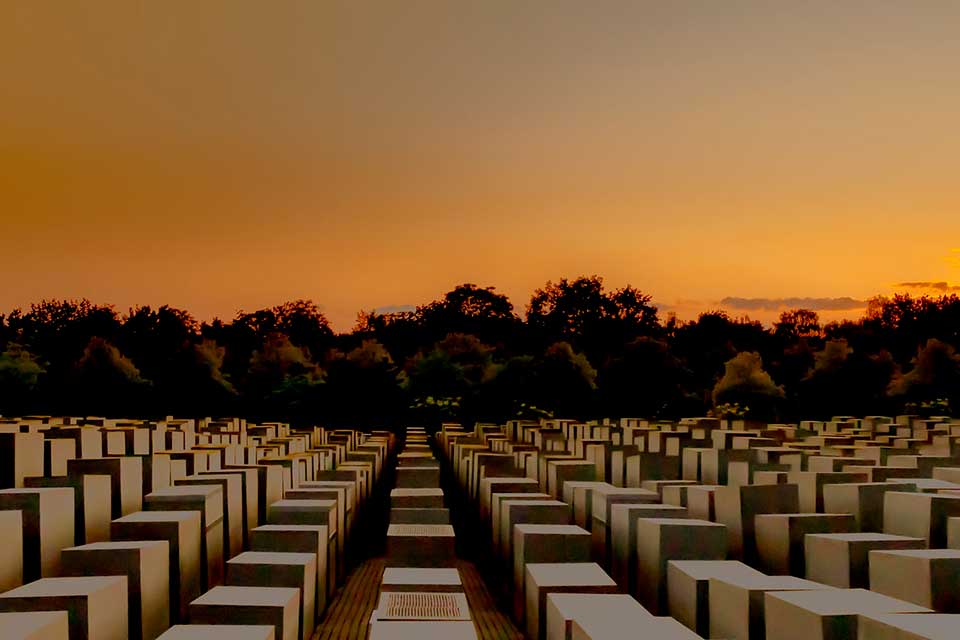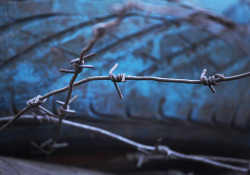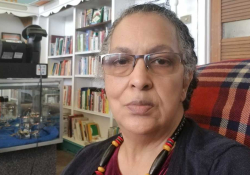What Happened in the Halle Synagogue Attack?

After every right-wing act of violence we hear once more that it was a “lone wolf” attack. Esther Dischereit argues that this is an implausible cover-up of attitudes sympathetic to Nazism.
On October 9, 2019, an assassin in Halle, Germany, shot two people and killed them, and he also shot several others, wounding them. He wanted to kill those who had come together in the synagogue on Yom Kippur, the highest Jewish Holy Day, and he put an incendiary device in the Jewish cemetery nearby. He didn’t succeed. When he realized he had failed to kill Jews, he killed Kevin S., who was in a snack bar for döner, a Turkish fast food. For the perpetrator, Kevin S. was, as it were, someone who associated with Turks, migrants, presumably also Muslims. He was shot for and instead of someone else. Jana L., a non-Jewish resident of Halle whom the perpetrator shot when he meant to kill the people inside the synagogue, also certainly died instead of Jewish people.
Katrina Turner, a representative of the African-American community in Charlottesville, broke out in tears when in 2017—after the Ku Klux Klan invaded her city—she recounted her memories of Heather Heyer, a counterdemonstrator who was killed, and of the many more were injured. Turner repeated this sentence twice: “. . . that a white woman died for us.” As the Ku Klux Klan supporters marched into town, they chanted this slogan: “The Jew will not replace us.” In this context, the figure of the “Jew” signifies that white domination of the world is under threat. In this sense, being Jewish is elevated to being simply “the other” and becomes a shorthand for all efforts and aspirations that could disturb the image of a healthy, pure “Aryan” people.
In such milieus the “Jew” also represents left-wing political positions and queer, feminist, and diverse worldviews, including ways of being human that supposedly bring decay, including taking in refugees and wanting to live as peaceful neighbors to Muslims. Each of these concepts is well known. Historically, this has not stopped these people from seeing Jews as a “red danger” while at the same time denouncing them as “capitalist bloodsuckers.”
“Happy about Every Synagogue”
The attack in Halle is different from what happened in Pittsburgh, Christchurch, and France not because of the ideological fanaticism, not because of the cold-bloodedness, but because the attack took place in a country where the “Final Solution” happened under Nazi rule. The image of people trapped in a synagogue is superimposed upon the image of people driven into a synagogue. The exits were blocked, and German Einsatzkommandos set the synagogue on fire. After millions of Jewish people had been killed or driven out, every political establishment after 1945 at first had to tolerate the few who remained and later on court them from time to time. After the October attack, Germany’s federal chancellor, Angela Merkel, declared that “we are happy about every synagogue, every Jewish community, and all Jewish life in our country.”
Up to now the Islamic community, with its roughly 4.5 million members in Germany, has not experienced such a public validation. Such attentiveness to mosques that have been set on fire or headscarves that have been spat on is still waiting to appear on the political stage. A few days ago at the event celebrating the ten-year existence of the only existing Jewish scholarship, the Ernst Ludwig Ehrlich Scholarship Fund (ELES), it was Hakan Tosuner, director of Avicenna, the Islamic Scholarship Foundation established five years ago, who said: “Precisely in light of yesterday’s tragic incident, Jewish-Muslim solidarity is more important than ever. . . . Whether synagogues or mosques are attacked, we must be united in solidarity.”
Perhaps it is inappropriate to express these thoughts publicly at this time. But it remains a fact that this threat has not just become evident now for the first time and that other citizens are also affected. The Roma and the Sinti peoples are continually exposed to an endless stream of threats that has made it necessary for this minority, too, to erect a special protective wall at the entrance to their center in Baden-Württemberg. Four days after Halle, Daniel Strauß, chairman of their association, received this threat of an attack on his cell phone: “After Halle, your cultural center is up next.” In Germany, Austria, and the Balkans, this minority was also a victim of Nazi racial fanaticism.
“Try to speak: I am glad you exist, that you exist here, among us.” It may strike one that perhaps this sentence sounds untruthful. It hardly seems right, and I must confess that I personally don’t demand such a statement. Absolutely no one has to be happy or not happy that I exist. I am here, all the same, whether someone else is happy about that or not. Is it the responsibility of government representatives to welcome me as a ward? Is this attitude legitimate simply because someone is a member of the majority?
“A Foreign Race”
It is basically a question of reversing an attitude of being unhappy about someone and wanting to send her or him “back home.” Donald Trump exemplifies this when he denies that the Democratic Congresswomen Ilhan Omar, Rashida Tlaib, and Alexandria Ocasio-Cortez are “real Americans.” The AfD (Alternative für Deutschland) politician Alexander Gauland recommended that the former German minister for integration Aydan Özoğuz should be “disposed of like waste material.” With reference to the same person, a party member said that she should care about “over there, where she belonged.” The opponent is said to be base, branded as “another race,” stigmatized as “the other” and foreign.
This use of the language by the legal political arm of the right-wing terrorist milieu continues in the struggle over public space, the struggle for the political opinion of others. Antifascist projects and initiatives on the left, booksellers, and others are overrun with incendiary devices and death threats. But it was only in June 2019 after the Christian Democratic Union district president of the city of Kassel, Walter Lübke, was murdered by the neo-Nazi Stephan Ernst that an outcry broke out in the political establishment.
Lübke fulfilled his obligation to take care of people who entered the country seeking protection as they fled dictatorship and civil war. He clearly injured the feelings of the right-wing extremists when he said that whoever did not agree with such values was at liberty to leave Germany. This murder followed a series of murders by the National Socialist Underground (NSU). Preceding this one, nine people, all of them migrants, were killed as well as a female German police officer, and a bomb attack injured more than twenty people in Cologne. The existence of the NSU was discovered in 2011. In the trial in Munich, which ended in 2018, Beate Zschäpe was sentenced to life in prison. In the eyes of those who were family members of the victims, the sentence exonerated the other accomplices who were accused. It was evident that the court had wanted to limit the group of culprits to a core of three and to the most immediate environment. Additional investigations were not done (e.g., in connection with a list of the right-wing extremists’ targets that was discovered). Two hundred and thirty-three goals referring to Jewish life were identified on this list. A greater number of targets referred to migrant communities, and others specified politicians and parties.
Ideological Incendiary Devices
Crimes motivated by anti-Semitism have taken place since 1980, with the murder of the rabbi and publisher Shlomo Lewin and his partner, Frida Poeschke, since the arson attack on the synagogue in Erfurt, those injured in Düsseldorf-Wehrhahn and in other places: 1980, 1992, 2000, 2003. . . . Nevertheless, after every right-wing terrorist act of violence we hear, repeated like a mantra, that this was an attack by a single individual. At first the danger from these networks assembled by neo-Nazis ready to do violence was perceived little by little. In August, the German Federal Office of Criminal Investigation counted those who posed a threat to public safety at forty-one, although the number of right-wing extremists ready to engage in violence has been identified as over twelve thousand. Their sympathizers are said to be as many as twice that. More than five hundred arrest warrants for neo-Nazis have not been served. Where were they sought?
After every right-wing terrorist act of violence we hear, repeated like a mantra, that this was an attack by a single individual.
It is about time that independent commissions investigate the security forces that not only refrain from proceeding against right-wing extremism but may themselves be involved. Many incidents involving police in Hesse, Thuringia, and in the army suggest this possibility.
The criminals of the National Socialist regime were largely left unpunished. This culture of immunity from punishment has continued and spread with regard to right-wing extremism in our democratic system. This is the real problem. The antifascist initiatives and archives have an extensive amount of research material at their disposal. It is thanks to them that not everything can be swept under the rug.
This culture of immunity from punishment has continued and spread with regard to right-wing extremism in our democratic system.
As the political arm of the culprits, the AfD denies that it had anything to do with these crimes. But they are the ones who for a long time have been planting ideological fire accelerants. Remarks against Jews are heard again and again from members of the FPÖ (Freedom Party of Austria); denial that an ideological system is at work here follows close on the heels of such statements. These are implausible cover-ups of an attitude sympathetic to Nazism.
Initiatives like “Indivisible” or “We are the many” make clear that they oppose the ethnically tinged “You are the stranger” with a “we.” In August of this year thirty-five thousand people demonstrated in Dresden in favor of this stance; thousands are once more in the streets. Citizens can demand that the right-wing extremists who commit arson, their spiritual mentors, and networks be investigated. Flirtation with such a body of thought is not only tasteless but, given the brutality of the milieu, it is the beginning of the end.
Translation from the German
Editorial note: The German original of this essay first appeared in Vienna’s Der Standard on October 19, 2019. Translated by permission.











